Toshiba Tecra R850: Business Class on a Budget
by Dustin Sklavos on June 6, 2011 12:01 AM ESTApplication and Futuremark Performance
I'm anxious to see how well Intel's fastest dual-core mobile Sandy Bridge performs, but the scales aren't quite as unfair this time as they were between Arrandale and Clarksfield: Sandy Bridge is a more efficient architecture, and the mobile quad-core chips scale impressively.
As Jarred has mentioned before, we've updated our benchmarking suite somewhat. PCMark05, 3DMark03, and 3DMark05 are no more. In their stead we've added PCMark 7, 3DMark 11, and Cinebench R11.5.

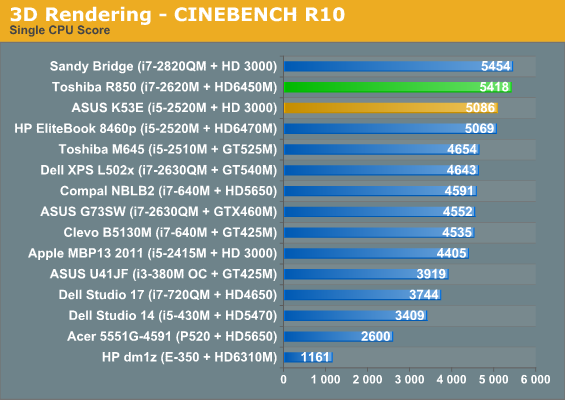
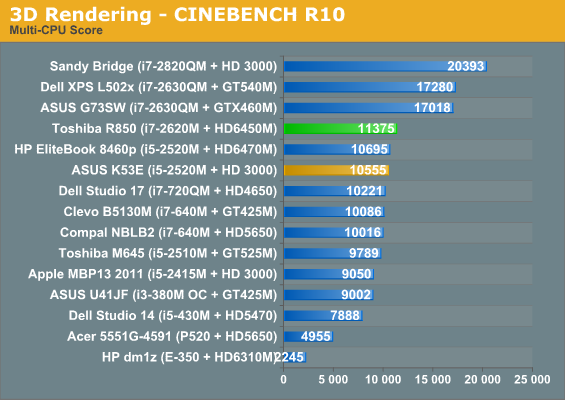
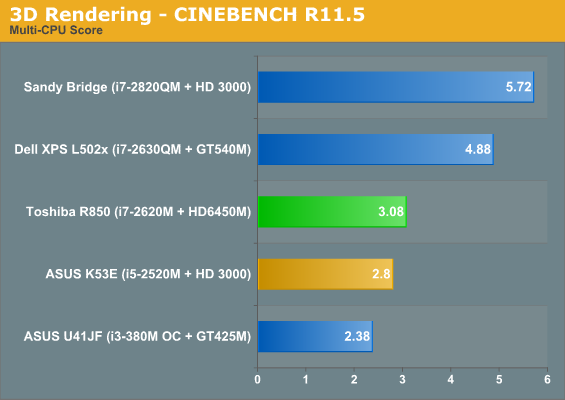
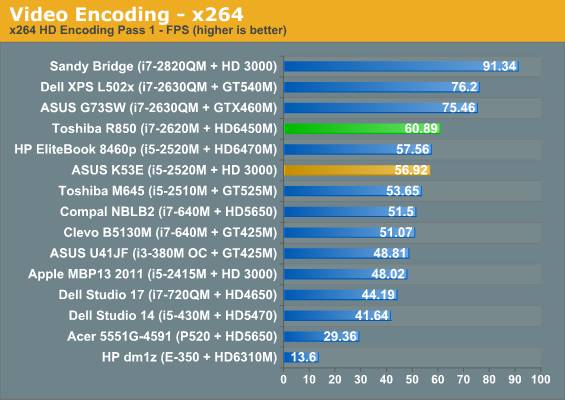
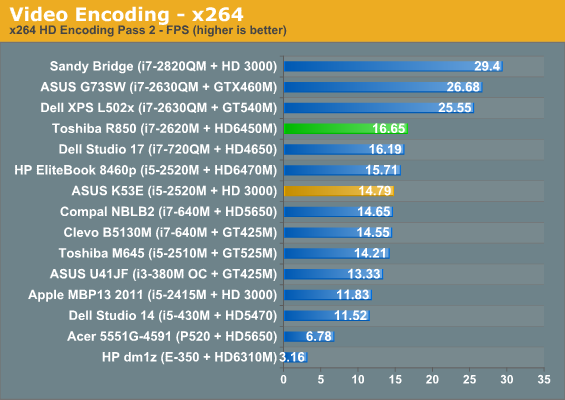
Since we don't really have any comparison points in PCMark 7 just yet, there's no sense in posting a graph with just one or two values, but the Tecra R850's score there was 1472 for reference.
As for everything else, the i7-2620M is clearly at the top of the dual-core heap, but while last generation's i7-620M and i7-720QM were able to tangle, the budget-minded i7-2630QM is generally a healthy upgrade from the 2620M--the exception being single-threaded workloads where the higher single-core puts it 17% ahead of the closest 2630QM. There are just some things a quad-core can do that a dual-core can't, and with Turbo Boost the advantages of dual-core are largely negated. Still, the Tecra R850 ranks very high on most of our charts.
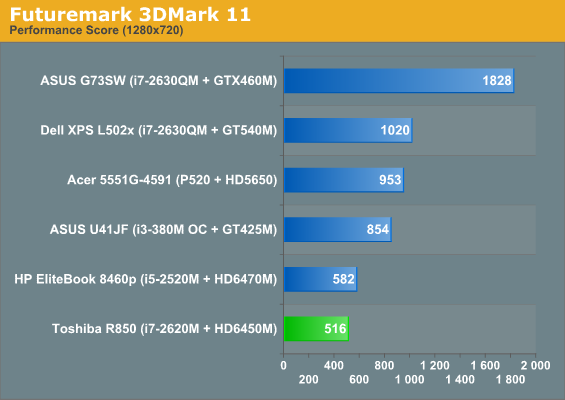
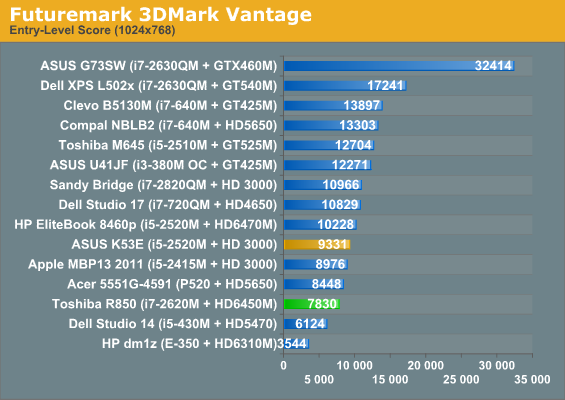
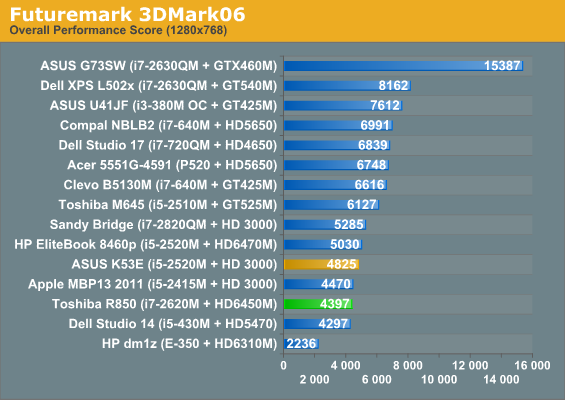
Unfortunately the Radeon HD 6450M seems to have a hard time hanging with Intel's HD 3000 integrated graphics in 3DMark, and worse, it takes a substantial performance hit from the 6470M in HP's EliteBook 8460p. Neither of these solutions are ideal, but the 150MHz deficit on the core clock going down to the 6450M hurts, and it's likely that the 200MHz deficit on the memory hurts even more so considering the 64-bit memory bus. It's worth noting that Intel still lacks support for DX11, so we can't generate a 3DMark11 score, but we'll see if 3DMark correlates with actual gaming potential next.










39 Comments
View All Comments
GotThumbs - Monday, June 6, 2011 - link
I look forward to the day when SSD drives will be more of a mainstream option.Nice Review as always.
dananski - Monday, June 6, 2011 - link
I've been thinking the same thing recently since I looked for a laptop for a friend on Dell's website and found she couldn't have an SSD without spending nearly £1000 (~$1650) for an Alienware gaming laptop she doesn't need (she has a desktop for gaming). Even then, Dell's only "SSD" option for non-business customers is actually a hybrid drive.A decent SSD makes even a low end system much more usable. It's not a feature that should be limited to the high end.
Stuka87 - Monday, June 6, 2011 - link
You can get SSD's on Latitudes, which cost less than an alienware box.The issue is Dell SSD's suck. So its far better to go with a base HD, and then buy an SSD from NewEgg or something. Its both MUCH cheaper, and you get a better drive.
Shinobi_III - Monday, June 6, 2011 - link
SSD would be more mainstream if general people understood why they would buy a laptop with 64gb instead of THREE THOUSAND!!!People are dumb, never underestimate the general public... :(
chrnochime - Monday, June 6, 2011 - link
I might be behind on the latest status of SSDs but last time I checked they still die much faster than HDs do with repeated read/writes, because of them being NAND(or NOR) cells and not discs. I'd jump on SSD if that's not the case anymore.JarredWalton - Monday, June 6, 2011 - link
General use with current wear leveling algorithms means the NAND should last upwards of 10 years on all current drives. The bigger problem is something else going wrong (i.e. faulty firmware, or some other glitch), so if you have critical data stored on an SSD I'd recommend a real backup strategy rather than just hoping for the best. If an HDD dies and you really need the data, you can pay data recovery firms a couple thousand dollars and usually get everything back. If you SSD dies, you're pretty much SOL.Roland00 - Monday, June 6, 2011 - link
13.3 inchi5 2410m
Nvidia Geforce GT540m with Nvidia Optimus (it uses 2gb of ddr3 though instead of gddr5)
It gets rid of the crappy acer island keyboard, but keeps the glossy screen and has the resolution at 1366x768.
No Optical Drive.
4lbs 1 ounce.
It is $779 at frys, I don't know what the other places are going to have since this is a new product and hasn't made much news yet.
warisz00r - Monday, June 6, 2011 - link
the also-new ASUS U41SV? It has pretty much the similar specs as the Acer above except it comes with a 14.1 inch screen, an optical drive, about 1" thick and comes in at about 2kg with an 8-cell batt. I'm hoping to get one of these as my new laptop.ppeterka - Monday, June 6, 2011 - link
Agreed with both of you! 15.6" AND HD resolution, AND business class? Oh my god, when will this end?And there is the absolutely redundant, never used keypad. Why?
Acers have a bad reputation regarding build quality (Me, and ym colleagues were having display problems in the Penryn era 57xxG notebooks), but I wouldn't buy this over the Acer 3830 series even if I was forced to. Big. Crap. And not THAT cheap! Even here in Hungary, Acer prices are quite reasonable, and they pack quite a punch for the money.
aylafan - Monday, June 6, 2011 - link
I just saw your title and it is incorrect. Make sure you are buying the 3830TG and not the 3830T.3830T = ONLY has Intel Integrated Graphics
3830TG = NVIDIA GeForce GT540M with Optimus Technology